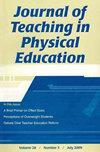汞和运动:季节性对校外时间高中设施使用的影响
IF 1.8
2区 教育学
Q2 EDUCATION & EDUCATIONAL RESEARCH
引用次数: 0
摘要
目的:在行为生态学模型的基础上,为了解决公园空间缺乏的问题,本研究在考虑季节性影响的情况下,研究了社区成员在非上课时间使用公立高中体育活动(PA)设施的情况。方法:数据包括在亚利桑那州19所公立高中校园1年(所有季节)的3959次观察扫描。结果:环境支持在季节之间存在明显差异,春季设施比夏季或秋季更易于访问,可用性和照明。无障碍设施通常在室外(68.6%的时间)。久坐行为的频率最高的是在夏季。结论:本研究扩大了我们对季节性因素对社区使用保健设施的影响的认识。在极端温度时期,寻找方法使室内PA设施更容易获得,以支持社区成员增加PA水平可能是有益的。本文章由计算机程序翻译,如有差异,请以英文原文为准。
Mercury and Motion: The Influence of Seasonality on Off-School Hours High School Facility Use
Purpose: Grounded in the behavioral ecological model, and to address a lack of park space, this study looked at community members’ use of public high school physical activity (PA) facilities during nonschool hours while considering the effects of seasonality. Method: Data included 3,959 observation sweeps across 19 public high school campuses over 1 year (all seasons) in Arizona. Results: Differences in contextual supports were evident between seasons, with facilities being more accessible, usable, and lighted in spring than summer or fall. Accessible facilities were most often outside (68.6% of the time). The highest frequency of sedentary behavior was in summer. Conclusion: The present study expands our understanding about the influence of seasonality as related to community access to PA facilities. During times of extreme temperatures, it may be beneficial to find ways to make indoor PA facilities more accessible to support increased PA levels of community members.
求助全文
通过发布文献求助,成功后即可免费获取论文全文。
去求助
来源期刊
CiteScore
4.20
自引率
21.40%
发文量
69
审稿时长
>12 weeks
期刊介绍:
The Journal of Teaching in Physical Education (JTPE) features peer-reviewed research articles based on classroom and laboratory studies, descriptive and survey studies, summary and review articles, and discussion of current topics of interest to physical educators at every level. JTPE is endorsed by the Curriculum and Instruction Academy of the National Association for Sport and Physical Education and the International Association for Physical Education in Higher Education.

 求助内容:
求助内容: 应助结果提醒方式:
应助结果提醒方式:


